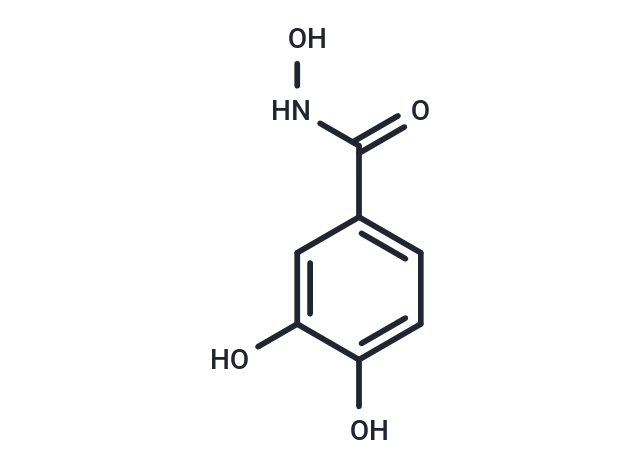Shopping Cart
- Remove All
 Your shopping cart is currently empty
Your shopping cart is currently empty

Didox (NSC-324360) is a synthetic ribonucleotide reductase (RR) inhibitor shown to reduce oxidative injury markers in the brains of HIV patients with dementia.

| Pack Size | Price | Availability | Quantity |
|---|---|---|---|
| 5 mg | $30 | In Stock | |
| 10 mg | $38 | In Stock | |
| 25 mg | $83 | In Stock | |
| 50 mg | $127 | In Stock | |
| 100 mg | $196 | In Stock | |
| 500 mg | $473 | In Stock | |
| 1 mL x 10 mM (in DMSO) | $31 | In Stock |
| Description | Didox (NSC-324360) is a synthetic ribonucleotide reductase (RR) inhibitor shown to reduce oxidative injury markers in the brains of HIV patients with dementia. |
| In vitro | Didox induced cell death and that this effect was suppressed by iron supplementation.?Cell treatments with didox caused changes of cellular iron content, TfR1 and ferritin levels comparable to those caused by the iron chelators, deferoxamine (DFO) and deferiprone (DFP).Didox is a bidentated iron chelator with two theoretical possible positions for the binding and among them that with the two hydroxyls of the catechol group acting as ligands is the more likely one. The iron chelating property of didox may contribute to its antitumor activity not only blocking the formation of the tyrosil radical on Tyr122 (such as HU) on RRM2 (essential for its activity) but also sequestering the iron needed by this enzyme and to the cell proliferation[1]. |
| In vivo | Didox treatment of mouse bone marrow-derived mast cells (BMMC) reduced IgE-stimulated degranulation and cytokine production, including IL-6, IL-13, TNF and MIP-1a (CCL3)[2]. |
| Cell Research | The cells were seeded in a 96-well plate (at a density of 2 × 10^3 cells for HA22T/VGH;?1.5 × 103 cells for HuH7) and exposed to various concentrations of didox and only HA22T/VGH also to hydroxyurea, DFO or DFP (0, 1, 10, 25, 50, 100, 200 and 500 μM) for 24, 48 and 72 h. In other experiments, HA22T/VGH were seeded in 96-well plates and treated with a single dose of didox, HU, DFO, DFP alone or in combination with increasing doses of FAC (25, 50, 100, 200 and 400 μM) for 48–72 h. In other type of treatment,?HA22T/VGH cells were or pre-treated for 16 h with a single dose of didox (200 μM) and then treated in combination with FAC (400–800 μM) or directly in combination didox-FAC for 48–72 h.Cell viability was evaluated with an MTT assay.?After the indicated time points and treatments, the supernatant was removed and 100 μL of the MTT solution (0.5 mg/mL) diluted in the cell medium was added to the wells.?After 3.5 h of incubation at 37 °C and 5% CO2, the MTT medium was removed and 75 μL of DMSO was added to each well.?Plates were shaken for 15 min at 37 °C until complete dissolution and absorbance was measured at 540 nm emission wavelengths.?Average percentage of cell viability at each concentration was calculated using Microsoft Excel 2016 software[1]. |
| Alias | NSC-324360 |
| Molecular Weight | 169.13 |
| Formula | C7H7NO4 |
| Cas No. | 69839-83-4 |
| Smiles | ONC(=O)c1ccc(O)c(O)c1 |
| Relative Density. | 1.571g/cm3 |
| Storage | Powder: -20°C for 3 years | In solvent: -80°C for 1 year | Shipping with blue ice. | |||||||||||||||||||||||||||||||||||
| Solubility Information | DMSO: 100 mg/mL (591.26 mM), Sonication is recommended. | |||||||||||||||||||||||||||||||||||
Solution Preparation Table | ||||||||||||||||||||||||||||||||||||
DMSO
| ||||||||||||||||||||||||||||||||||||

Copyright © 2015-2025 TargetMol Chemicals Inc. All Rights Reserved.